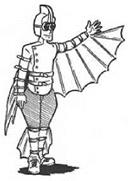The Earliest Aviators
|
|
In This Chapter
V The universal dream of flight
^ The Greeks and early flying stories
V Leonardo da Vinci: the first aviation inventor ^ Balloons "take off" in popularity
V The first airplanes: gliders
— ~ ‘ "— —————————– ■———————————————– ‘
Human beings have always been flyers—all we lack are our own wings. From the time our ancestors carved pictures on the walls of caves, we have dreamed of what it might be like to soar with the birds.
For those of us with a passion for the sky, those dreams still fuel our imagination. Sigmund Freud might disagree, but it’s possible that no other dream is as universal as the dream of flying. It’s easy to understand why. Flying releases us from the grip of gravity and enables us to soar effortlessly above the ground, where everything from impassable terrain to bumper-to-bumper traffic hinders and frustrates us. Flying enables us to take our fortunes in our own hands and provides us with a tool that carries us—quite literally—to heights and destinations we might not otherwise have seen.
But many of us love flying for reasons that go deeper than its ability to move us quickly from one nation to another, or from our hometown airport to our favorite fishing lake. For us, flying is a way of expressing our spirit of adventure and our desire
to push ourselves to greater challenges. And to make it even more exciting, there is a thrilling hint of danger thrown in. Although statistics show that some forms of flying are safer than driving a car, no one can deny that flying carries with it some risk.
|
Turbulence Don’t be fooled by bad science fiction movies that show screaming cavemen and cave women being carried to their doom by giant pterodactyls. Humans appeared about 194 million years too late to see a Irving pterodactyl. In any case, because the early species of pterodactyls grew to about the size of a sparrow, they would have had their claws full to carry much of anything. |
|
On Course The surest way to get hooked on flying is to spend an afternoon at your local airsthp watching the airplanes come and go. From a safe location outside the airport boundary, you’ll begin to sense the pace and character of flying— and you’ll fall in love with it. Warning: Aviation can be habit – formingl |
Tragedies like the death of John F. Kennedy Jr. in a flying accident in July 1999, remind us that flying can be unforgiving if we aren’t careful. But the death of JFK Jr. also created more interest in flying because many of us read in news reports about how much he loved to be in the air. Kennedy loved flying and he flew his airplane whenever he could, taking friends and family along with him sometimes, just to share the fun.
What is it about flying that some people find so addictive? From the wise old pilots that hang around airports—the “hangar bums” or “ramp rats” as they are affectionately called—to the sounds and sights of planes arriving and departing from the landing strip, flying has an unmistakable mystique. In addition to the indescribable feeling of taking off into a beautiful spring sunrise or flying over the breathtaking landscapes of the Southwest or the great Smoky Mountains, there is a delightful social culture that makes every plane lover feel welcome, even if they haven’t yet earned their wings.
In order to fully appreciate the culture of flying, let’s take a look at how flying began and at some of the heroes who made it what it is today.














